
In 2015, I devoted two e-newsletters (July and November) to explaining the concepts behind what I call "Todd's Hypothesis" – ;namely ...
|
It is impossible to ... |
Reduce Process Cycle Time |
or ... |
|
Improve Process Quality |
without also achieving ... |
|
|
Lower Process Cost |
as a natural by-product. |
An implication of "Todd's Hypothesis" is this – Reduced Cycle Time, Improved Quality, and Lowered Cost are equivalent to one another.
I'd originally planned for this article to only have two parts; however, developing answers to questions on Part One from my most loyal reader – my brother Rhett! – led to new and interesting material, enough for this month's e-newsletter.
The timing is perfect, too, given recent current events. Rhett is a Professor of Physics at Radford University, in Radford, VA, and received his PhD from Montana State University in Bozeman, MT, where his dissertation was "Generalized DeWitt-Schwinger Point-Splitting Expansions for the Charged Scalar Field in Curved Space."
Loosely translated, Rhett studied the physics of black holes! Not only is he smart, he's also a great teacher, having won two teaching awards from Radford University – "College of Arts and Sciences Distinguished Teaching Award 1999-2000" in May 2000, and the "Donald N. Dedmon Distinguished Teaching Professor Award" in May 2007. (For more on Rhett, please visit: http://www.radford.edu/~rherman/. For more of what Morgan and Shane call "Uncle Rhett's Big Toys," please visit: http://www.radford.edu/content/csat/home/ru-planetarium/new-planetarium.html.)
If you're a science nerd like Rhett and me, you were surely excited by the announcement, on February 11, 2016, that scientists had detected the existence of gravitational waves generated 750 million years ago by the merging of two massive black holes, thereby proving a nearly 100-year-old prediction by Einstein! (For more on this discovery, please see articles in Science News and The New York Times.)
Rhett, physics, black holes, Einstein, all in February 2016 – wow!
Rhett's Questions
So, here is Rhett's email:
Hi Todd,
Question about Todd's Hypothesis:
http://www.toddherman.com/improve-business/Todds-Hypothesis-Part-One
If you push out one corner of the triangle, is there some "restoring force" so that the sides are more spring-like? Similarly, if you manage to force the shortening of one of the sides, does it also "push back"? Again, spring-like, but in the opposite direction. To me, the springs would work towards some type of equilibrium that may or may not be as beneficial to you and/or your clients.
Just a thought. It always seems to me like I hear the phrase "push-back" a lot when people discuss changing the way things currently are done/offered.
This could also be completely meaningless, by the way, since I have zero (that's 1-1, nothing^2, everything-[everything], zip, zilch, nada) business/accounting/consulting/systems knowledge/experience.
Rhett
***********************************************************
Dr. Rhett Herman, Professor of Physics
Curie Hall #135
Department of Physics, PO Box 6983
Radford University , Radford, VA 24142
(540) 831-5441 (office), (540) 831-5652 (dept.), (540) 831-5732 (fax)
GREAT questions, Bro!
In the first two parts of this article, I wrote about two types of triangles – one for Project Management, and another for Process. Let me answer Rhett's questions using both triangles.
"The Project Management Triangle"
A Project Management (PM) triangle starts off as this, where the Cost, Timeline, and Scope have been balanced to fit management's expectations.
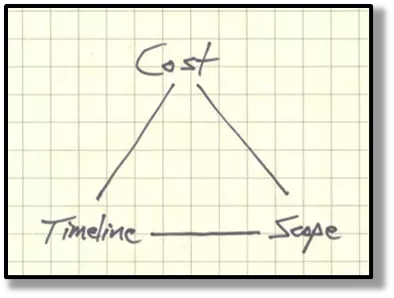
Let's take a fairly common project, the implementation of a new business system. Almost always, some slippage of the timeline comes during implementation, causing the triangle to no longer be balanced.
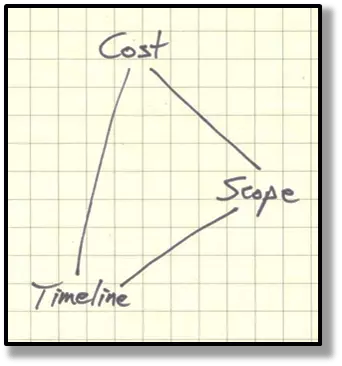
Rhett asks about "push-back" by people asked to change the way things are done – yes, that can and does happen frequently. Push-back can push out the "Timeline" corner, as can many other factors.
Rhett wonders what the restoring force would be to return the Project Triangle to an equilateral state. Well, that restoring force is called "Money." Unfortunately, the triangle can NEVER be restored to its original state, once slippage occurs – the best that can be achieved is hitting the implementation date with the same implementation scope, yet at a higher cost.
Additional money can get a project back on track, yet this pushes out the "Cost" corner of the Project Triangle. Thus, the REVISED Project Triangle will be equilateral, because it aligns management's REVISED expectations – however, it will be a LARGER triangle than the original one.
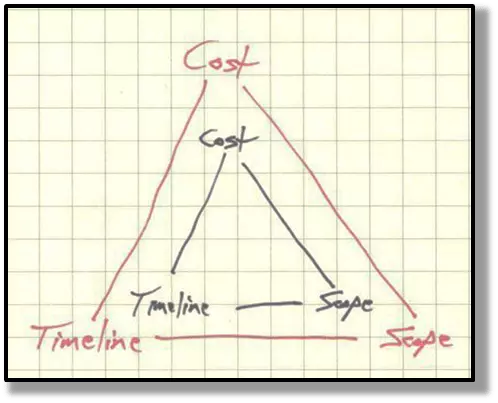
"The Process Triangle"
Interestingly, the Process Triangle can NEVER be anything other than equilateral!
Why? Because "Cost," "Cycle Time," and "Quality" are all measurements of the Process itself! And, as I've previously discussed, these three measurements are really just different lenses through which the same process is viewed.
Now, to Rhett's question about "push-back" by people being asked to change the way they do things. Because people are being asked to change things, there is an assumed goal of improving the Process. In the next doodle, the ORIGINAL Process metrics are depicted by the black triangle, and the GOAL Process metrics are depicted by the green triangle, assuming all changes are made as designed.
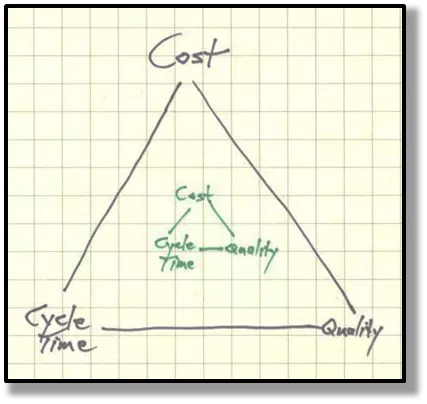
Let's say one or more people don't "get it" and can't – or won't – fully implement the necessary changes. What happens? Well, the Process is improved – it's just the improvements are not as much as could have been achieved. Here's the triangle, reflecting the ACHIEVED metrics for the Process, as drawn in blue.
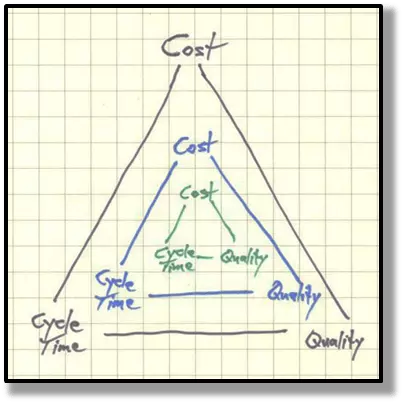
Dance of the Triangles
What's different about the triangles?
- The Project Management Triangle is about EXPECTATIONS of a Project. Since the Project is really only a concept being implemented, the Project cannot have any expectations about itself. Expectations are a function of the PEOPLE sponsoring, implementing, or funding the Project.
- The Process Triangle is about the ATTRIBUTES of a Process. While people may have EXPECTATIONS about the SIZE of this triangle, the LENGTH of the sides reflect the measured ATTRIBUTES of the process itself. Remember, these attributes are just different types of measures of the SAME process.
A Project might be undertaken to change a Process. Thus, a PM Triangle will be established to reflect expectations for the Project, having the goal of improving the Cost, Quality, or Cycle Time measurements of a Process – that is, the goal of a Project is to reduce the SIZE of a Process Triangle.
- Over the life of the Project, the PM Triangle – starting from equilateral – will morph, as expectations about the Project change as work progresses. If all goes well, the ending PM Triangle will be the same as, or very close to, the original PM Triangle.
- As the Process is changed, the Process Triangle will grow or shrink – yet always keeping all sides the same length. Remember – the metrics are DIFFERENT measures of the SAME Process.
Let's Add a Venn Diagram ...
At the risk of inducing MEGO (My Eyes Glaze Over) by "Math Overload," here's a diagram we use to explain how People, Process, and Technology work together to yield business Results (reflected by ROI, or Return On Investment):
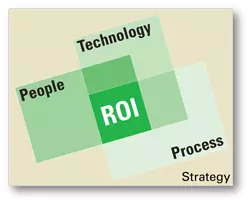
The way I look at things, the less the three squares overlap, the lower the ROI achieved – conversely, the higher the overlap, the better the results.
Now, Let's Bring It All Together ...
Let's say a Project is undertaken to improve Results, or ROI. These improved results come from some combination of Process improvement, Technologyusage, or People development. Our Projects typically presume a client's People are already good – thus, better ROI will come from improving Processes or using Technology.
How might a Project be negatively impacted by the components of the Venn Diagram? There are many ways for People, Process, and Technology to impact the Timeline, Scope, or Cost of a Project. Continuing with our System Implementation example, here are a few:
- People – Some examples include:
- People either cannot or will not make the changes needed to improve ROI. In this case, the client has a People problem, and needs skills other than ours. Even so, the management decisions boil down to:
- People Lack Aptitude – Train them.
- People Lack Attitude – Keep them and accept lower results, or get different people and work for better results.
- A key person has a death in the family, or goes out on maternity leave.
- A client is already leanly staffed, and then business takes a sudden and sustained upswing, perting time and attention from the Project.
- Client personnel lack the experience to see the various implications of a particular feature or quirk of a business system. This is especially true if the system is implemented in relative "silos" – either by the system's vendor or the client's personnel – and no one combines the "feet on the ground" perspective with systems savvy and subject matter experience.
- People either cannot or will not make the changes needed to improve ROI. In this case, the client has a People problem, and needs skills other than ours. Even so, the management decisions boil down to:
- Process – A few ways, among others:
- Vendor personnel might not fully understand how a client wants the system to run its business, and instead make suggestions which worked for another company.
- A process might fit the system and the client just right, yet the client lacks the necessary data – having either "dirty data" or NO data at all – to implement the process.
- Technology – These might include:
- A system is a great overall fit for a business, yet lacks a few key features for specific areas. Rather than try to customize the software to your operations, FIRST conform your operations to fit the process presumed by the software, THEN work with the software vendor to change the software for ALL its customers, since others will likely have similar needs.
- Some parts of the system have just been recently developed or enhanced, and they're not quite ready for prime time.
Thanks, Rhett!
Bro, thanks for being willing to ask the dumb questions – a premise of the books A More Beautiful Question and Getting Naked – which weren't really dumb at all! In fact, your questions helped me find other insights from the triangles, and give them voice.
Remember, asking questions is the only way we learn things, and the better we form our questions, the more likely we are to obtain helpful answers.
Indeed, if Einstein had not asked himself great questions, we would not have his theories of relativity – and without those, we would not have even thought to look for evidence of black holes colliding and warping the very fabric of space-time itself.
I wonder what Einstein would think about "push-back" and other "people problems." Perhaps that's why he was a physicist – he knew people were more mysterious and less predictable than black holes.
Sincerely,

Todd L. Herman






